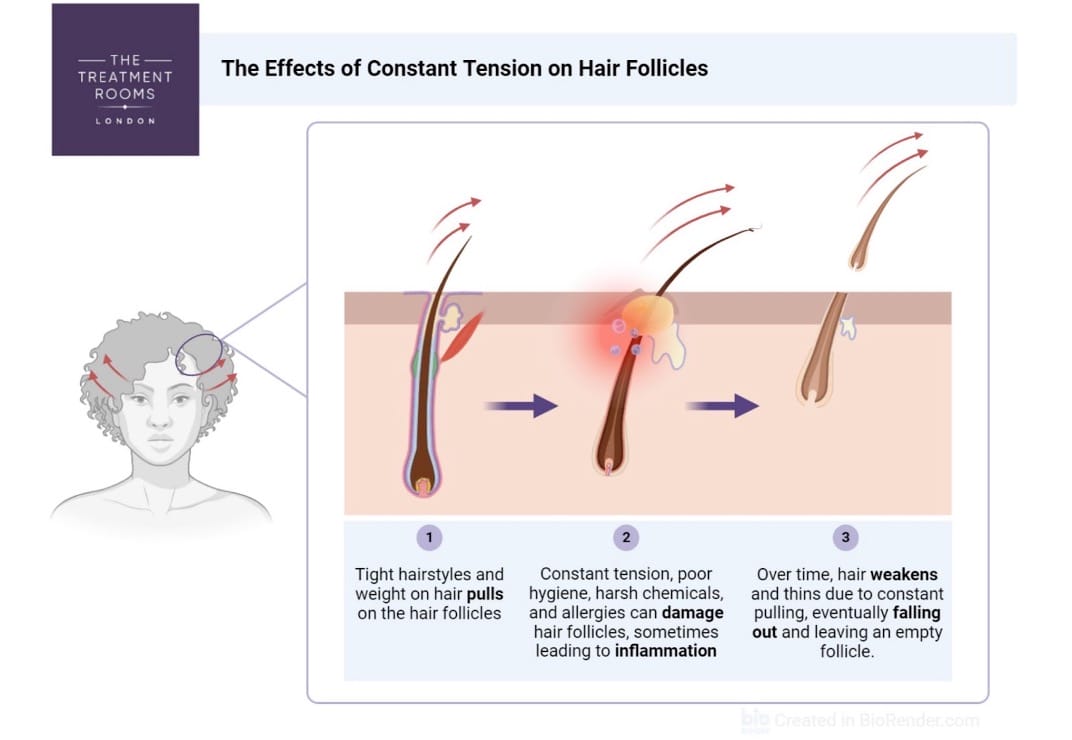Traction alopecia is a form of hair loss that occurs due to continuous pulling and tension on hair roots. It is commonly seen as hair loss affecting the hairline, temples, sideburns and the nape of the neck due to long term tight hair styling such as braids, buns or ponytails.
Hair transplant surgery can be an effective treatment for traction alopecia, restoring hair in areas where it has been lost.
What is traction alopecia?
Traction alopecia is a hair loss secondary to repeated pulling on hair roots. Over time, this tension causes the roots to weaken and fall out. This is depicted in the diagram below.

Traction alopecia can be categorised into short term or long term traction alopecia. If you have just started to notice hair loss from repeated hair tension styling then hair is likely to grow back if you stop styling your hair tightly. If you have styled your hair under tension for a years it is likely the hair loss you have is permanent. In such cases a hair transplant may be the best option to restore your hair.
Who can develop traction alopecia?
Since this form of hair loss is attributed to hairstyles that have a pulling nature, people who do braids, dreadlocks, weaves, and others like ponytails have an increased risk of developing traction alopecia than those who do not. Some commentators believe David Beckham had a form of traction alopecia and perhaps underwent hair transplant surgery to correct his hair loss.

In a review published by John Hopkins Medicine, traction alopecia was found to have a strong connection with scalp-pulling hairstyles. And since patients from an African-American background tend to style their hair in similar ways, traction alopecia was found to affect about one-third of them, mainly women. Thus, solidifying its place as the leading cause of hair loss among this group of women.

That being said, traction alopecia can affect anyone that continuously pulls on their hair when they style and groom it.
How is traction alopecia treated?
According to most sources, the best way to treat traction alopecia is by prevention. This includes letting your hair fall and rest without tension. If hair damage has already started, but hasn’t caused permanent loss, then doctors often recommend behavioural changes and one or more medications such as Minoxidil. However, when traction alopecia has caused hair loss, then one of the options to treat the affected area is a hair transplant.
What is a hair transplant?
A hair transplant is a medical procedure that involves moving hair from the back or sides of the head (donor area) to a bald area of the scalp. It is usually carried out to reverse permanent hair loss. In conditions like traction alopecia, especially when it gets to a chronic stage, hair transplants can be the best way to restore hair growth.
Hair transplant for traction alopecia
The two most common hair transplant techniques used in treating traction alopecia are the Follicular Unit Excision (FUE)and Follicular Unit Transplant (FUT) methods. Often hair transplant surgery for traction alopecia will involve transplanting hair into the temples, hairline and sideburns as these are the most common areas affected by the condition.
FUE hair transplant for traction alopecia
- In follicular unit excision, individual hair follicles are extracted directly from the donor site of the scalp — which is usually the back of the head.
- After extracting these follicles, the surgeon makes tiny little holes at the recipient area of the scalp, and then carefully place new hair into these holes.
- At a single transplanting session, the surgeon can harvest and transplant hundreds or even thousands of hair follicles.
- Due to the amount of time required to do this kind of procedure, one may have to do several sessions before getting their desired hair growth in an area affected by traction alopecia.
- You can calculate how many grafts you may require in our graft calculator or read our article: how many grafts do you need for your hair transplant

Follicular unit transplant (FUT) for traction alopecia
- In a follicular unit transplant, a surgeon uses a scalpel to cut out a strip of scalp skin, usually from the back of the head. After taking out the incision, which is typically several inches long, the surgeon then stitches up the affected area.
- The next stage involves taking the extracted scalp or incision, and separating it into numerous individual grafts, from which individual hair follicles are extracted too.
- After preparing individual hair follicles, the next step is to transplant them into the area affected by hair loss. This involves making delicate tiny holes in the scalp, and then re-implanting the prepared hair follicles. The process can take several hours for a large area affected by traction alopecia
Recovery after a traction alopecia hair transplant
After a hair transplant for traction alopecia, it will take some time for your hair to grow. This is because the transplanted hair follicles must fully adjust and fit in properly in their new environment before they can start growing just like the other hairs. Generally, it can take up to 3 months before you begin to notice any significant hair growth. You can see a full timeline of growth following a hair transplant in our hair transplant timeline.
Commonly, patients find that their transplanted hair falls out after a few weeks following surgery. This is considered a natural part of post-hair transplant processes.
Following the surgery, doctors often recommend medications to reduce pain, antibiotics to reduce the chance of infection, and anti-inflammatory drugs to lower inflammation of the scalp. Most patients have fully recovered after their hair transplant after 7 days have passed.
Aftercare for traction alopecia hair transplant
Your doctor can also recommend the intake of certain vitamins and minerals. Popular ones include vitamin C, vitamin D, biotin, and other B-group vitamins. Vitamin C in particular can help accelerate the healing process of your scalp due to its involvement in wound healing processes, especially if the follicular unit transplant (FUT) technique was used for your surgery. Others like biotin have gained popularity for helping with hair growth and improving the mechanical strength of hair strands, thanks to its ability to boost keratin production.
Apart from medications and supplements, there are many numerous post-transplant instructions that must be followed. Some of them include:
- Avoiding exercise for 2 weeks
- Avoiding direct strong sun for 2-4 weeks
- Avoiding harsh chemicals on your hair for as long as possible following surgery such as hair dye
- Stopping the styling of hair that causes traction on existing and newly growing hair as this can cause hair transplant failure where you the subsequently need a second hair transplant to repair your result
Summary
Traction alopecia is mostly caused by hairstyles that create a pulling force on the roots of the hair. When noticed early enough, it can be prevented and successfully treated. But when left unnoticed, it can lead to permanent hair loss — a condition that can be treated with a hair transplant.
If you are exploring having a hair transplant for traction alopecia, book your consultation today. Our lead surgeons will be more than happy to give you more information on the personalised hair transplant service we offer at The Treatment Rooms London.
References
- https://www.unitedcareclinic.com/blog/hair-loss-statistics-facts/
- https://www.ncbi.nlm.nih.gov/books/NBK547740/
- https://www.ncbi.nlm.nih.gov/books/NBK538178/
- https://www.ncbi.nlm.nih.gov/books/NBK470434/
- https://www.hopkinsmedicine.org/news/media/releases/all_hairstyles_are_not_created_equal
- https://www.ncbi.nlm.nih.gov/books/NBK547740/
- https://pubmed.ncbi.nlm.nih.gov/24796079
- https://www.ncbi.nlm.nih.gov/pmc/articles/PMC6218806/
Share:
Authored by
Reviewed by
Book a Consultation
Related Blogs
When Can You Safely Wear a Beanie After a Hair Transplant?
July 3, 2025
Quick Summary Cap Recommendations: Light, breathable caps, such as snapbacks or trucker hats, are advisable if you need…
Castor Oil (Ricino Oil) for Hair Growth: Benefits, Uses & How to Apply for Maximum Results
June 26, 2025
Castor oil, also known as Ricino oil, is extracted from the Castor bean plant (Ricinus communis). During…
What is a Hair Transplant? How it Works, Success Rate & What to Expect
June 23, 2025
Hair transplantation is a cosmetic surgical procedure that restores hair by moving healthy follicles from one part…
John Cena Hair Transplant
May 14, 2025
John Cena, a common household name, is a figure who has effortlessly straddled the worlds of professional…
Kyle Walker Hair Transplant: Before, After, and His New Hairline
May 12, 2025
Kyle Walker is known for his defensive skills at Tottenham Hotspur, Manchester City, and in the England…
Celebrity Hair Transplants: Full Before and After Analysis
May 8, 2025
Elon Musk Hair Transplant Elon Musk, the billionaire behind Tesla and SpaceX, is well-known for his innovations…
Lewis Hamilton Hair Transplant: Before, After, and His New Hairline
May 7, 2025
As a top-class racing driver, Hamilton is used to wearing a race helmet. While this does protect…
James Nesbitt Hair Transplant: Before, After, and His New Hairline
May 6, 2025
James Nesbitt, the Northern Irish actor famed for his role as Adam Williams in the British comedy-drama…
How Many Hair Grafts Do You Need For A FUE Hair Transplant?
May 3, 2025
An Follicular Unit Excision (FUE) or FUT hair transplant are 2 main procedures available to address hair…











